The Imaging Resource
Quick Review
Kodak EasyShare P850 Digital Camera
| Kodak EasyShare P850 Digital Camera | ||
Review Date |
||
User Level |
||
Product Uses |
||
Digital Camera Design |
||
Picture Quality |
Very Good, 5.0-megapixel CCD | |
Print Sizes |
Very Good, 11x17s or 8x10s with heavy cropping | |
Availability |
||
Suggested Retail Price (At introduction) |
||
Introduction
|
||||||||||
Anyone accustomed to Kodak's EasyShare line of digital cameras will appreciate the blend of complex exposure options and ease of use found in the EasyShare P850. Similar in style to a traditional 35mm camera, though much more compact, the P850 offers advanced photography control for those who want it, as well as a healthy selection of automatic and preset shooting modes for novices. Featuring a 5.0-megapixel CCD, a whopping 12x optical zoom lens, and the full gamut of exposure modes, the P850 should appeal to a wide audience. Though the camera is slightly more advanced than many of its EasyShare cousins, the P850 maintains a user-friendly interface that's uncomplicated and straightforward. Novices will enjoy the large selection of preset scene modes, while more experienced shooters will appreciate the manual control options.
The P850 features a 2.5-inch, color LCD monitor with a very bright display, as well as a smaller LCD display in the electronic optical viewfinder (EVF). A brightness adjustment allows for bright or dark viewing situations, and the detailed information displays report in-depth exposure information, with an optional histogram showing the tonal distribution throughout the image. There's also a Highlight Clipping display mode, which flashes any overblown highlights in review mode. The camera's image-stabilized 12x optical zoom lens is equivalent to a 36-432mm lens on a 35mm camera, not so wide, but very long. Apertures range from f/2.8 to f/8.0, depending on the zoom setting, and can be manually or automatically adjusted. Focus ranges from 3.9 inches to infinity in the normal AF mode, which includes the Macro range. You can manually set the AF point to one of 25 spread across the frame, or opt for Multi-pattern or Center-weighted options. There are also Single and Continuous AF modes, and Manual and Landscape focus options. A set of filter threads inside the lens barrel accommodates Kodak accessory lenses, and a removable, plastic lens cap protects the lens when not in use. As noted, the P850 features Image Stabilization technology, which reduces the effects of minor vibration when shooting with the lens at full telephoto. (An extremely handy feature with a long-zoom camera like the P850.) In addition to the camera's 12x optical zoom, the P850 also offers as much as 3.3x Advanced Digital Zoom. However, I always caution readers that digital zoom frequently results in lower resolution and image quality, since the camera is essentially cropping out the center portion of the CCD and enlarging it.
While it does a good job optically, the P850's lens (more specifically its autofocus system) was the source of most of our complaints about the camera. The autofocus system worked quite well under daylight conditions, and in fact is faster than those of many long-zoom cameras we've tested. Under dimmer conditions (even normal office lighting) though, the autofocus performance decreased dramatically, particularly at longer zoom settings. (Here in the office as this is being written, it's taking upwards of two seconds to focus on a well-lit object about 15 feet away.) As the light dims further, autofocus times increase proportionately, and the camera would have a very difficult time indeed focusing under typical city street-lighting at night. (Although, the presence of bright lights within the scene would likely let it focus.)
The other foible of the P850's autofocus system is that the camera often took as long as a couple of seconds to readjust its focus after even tiny adjustments to the zoom setting. The delay in returning to a sharp viewfinder image was long enough that it significantly interfered with framing the subject. Essentially all digital cameras need to adjust focus in response to zoom changes, but the P850 is particularly slow in doing so, at least when the focal length is being shifted from longer to shorter settings. (For whatever reason, the P850 behaves normally when moving from wider to more telephoto focal lengths, only showing the aggravating delays when shifting to more wide angle settings.)
When it comes to exposure, the P850 offers as much or as little control as you could want. An Exposure Mode dial on top of the camera offers Auto, Program AE, Aperture Priority, Shutter Priority, Manual, Scene, Movie, and three Custom presets. The Auto exposure mode gives the camera complete control over the exposure and most shooting options, though you can adjust focus and zoom, as well as image size and quality. Program AE opens up the creative tools, though aperture and shutter speed remain under automatic control. Aperture and Shutter Priority modes allow partial manual control, and Manual mode gives the user complete control over the exposure. The Custom settings let you save a bank of user settings, useful if you frequently shoot in the same location or under a specific light source. An extensive Scene menu is available as well, offering no less than 16 preset modes for common yet tricky conditions. Scene offerings include Portrait, Self-Portrait, Sport, Landscape, Night Portrait, Night Landscape, Snow, Beach, Text, Flower, Sunset, Candle Light, Backlight, Manner/Museum, Fireworks, and Party.
For determining exposure, the P850 employs a Multi-pattern metering system, which takes readings from several areas throughout the frame. Also available are Center-weighted, Center-spot, and Selectable Zone modes, the latter of which lets you manually select one of 25 points in the frame for exposure readings. You can lock the basic exposure or flash exposure using the AE/AF Lock button, and exposure compensation is adjustable from -2 to +2 exposure values (EV) in one-third-step increments. If you're unsure about the exposure, an Auto Exposure Bracketing feature captures three or five shots at different exposures. The camera also offers an ISO adjustment (64 to 800 equivalents), as well as sharpness, contrast, and saturation adjustments.
Eight white balance modes are provided, including Auto, Daylight, Cloudy, Open Shade, Sunset, Tungsten, Fluorescent, and Custom (manual setting). The Custom option lets you save as many as three white balance presets, and you can customize the color balance manually using a small color grid. Also available are black & white and sepia shooting modes.
The P850 features a built-in pop-up flash, in addition to an external flash hot-shoe. The hot shoe can be used with a range of third-party flash units, and works either in conjunction with the built-in flash or by itself. The AE/AF Lock button locks the exposure for the flash when enabled, and a Flash Exposure Compensation feature alters the flash exposure from -1 to +1 EV in one-third-step increments.
The P850 offers First and Last Burst shooting modes through the Drive setting, which capture approximately 2.3 frames per second. (The actual frame rate and number of frames in a sequence will vary depending on memory card space, image size, and the amount of image information to record.) The Drive options also include two different Self-Timer options, and a Time Lapse Burst mode. A Movie option records moving images with sound at either 640 x 480 or 320 x 240 pixels, at 30 frames per second.
Image resolutions include 2,592 x 1,944; 2,592 x 1,728 (3:2); 2,048 x 1,536; 1,664 x 1,248; or 1,280 x 960 pixels, with JPEG compression levels of Fine, Standard, and Basic available. TIFF and RAW image options are also available. The P850 is accompanied by a USB interface cable for a speedy connection to a computer, as well as a dock insert for use with Kodak's optional printer and camera docks. Kodak's EasyShare software is included with the camera, for use on both PC and Macintosh computers. For power, the P850 uses a rechargeable Li-Ion battery pack or an optional AC adapter, and a single battery and charger come with the camera.
Basic Features
- 5.0-megapixel CCD (effective) delivering image resolutions as high as 2,592 x 1,944 pixels.
- Electronic viewfinder (EVF).
- 2.5-inch color hybrid LCD monitor.
- 12x optical zoom lens, equivalent to a 36-432mm lens on a 35mm camera.
- 3.3x digital zoom.
- Auto, Program AE, Shutter Priority, Aperture Priority, and Manual exposure modes, plus 16 Scene modes.
- Shutter speeds from 1/1,000 to 16 seconds.
- Built-in pop-up flash with five modes and flash compensation adjustment.
- Hot shoe for connecting an external flash unit.
- RAW, TIFF, and JPEG image file formats, with three JPEG compression settings.
- 32MB internal memory.
- Images stored on SD/MMC card (not included).
- Power supplied by rechargeable Li-Ion battery pack (charger included) or optional AC adapter.
- Compatible with Kodak EasyShare camera and printer docks (dock insert included).
- Kodak EasyShare interface software included on CD-ROM.
Special Features
- Image Stabilization reduces blurring from slight camera movement.
- Movie mode with sound.
- Burst and Time Lapse shooting modes.
- Auto Exposure Bracketing.
- 25-point autofocus area, with Center-weighted and Multi-pattern modes.
- Single and Continuous AF modes, as well as a manual setting.
- 25-zone Selectable metering system, as well as conventional Center-Weighted, Multi-Pattern, and Center-Spot metering systems.
- Custom exposure mode for saving user settings.
- Dual-mode AF system for faster focusing in low light.
- Two- or 10-second Self-Timer for delayed shutter release.
- Color, sharpness, and contrast adjustments, plus black & white and sepia options.
- User adjustable White Balance setting with eight modes, including a manual option and compensation tool.
- Sensitivity equivalents from ISO 64 to 800.
- DPOF (Digital Print Order Format) and PictBridge compatibility.
- USB cable for connection to a computer (driver software included).
- A/V cable for connection to a television set.
Recommendation
The Kodak EasyShare series of digital cameras continues to be a popular option for many consumers, due to its ease of use and consistent picture taking quality. With the full range of manual and automatic shooting modes, plus a very healthy selection of preset Scene modes, the P850 is quite capable for just about anything you can throw its way. The uncomplicated, easy to understand interface means you won't spend much downtime learning the camera, and the range of exposure control modes will appeal to both novices and enthusiasts alike. The EasyShare P850's 12x optical zoom lens and bounty of features will likely be a crowd-pleaser, and the fairly compact body (considering the long lens) will be much less cumbersome for travel than a more serious digital SLR. Yet again, Kodak has improved the EasyShare line with a more feature-laden digital camera, without compromising the "easy" in the name.
Styled similar to an ultra-compact 35mm film camera, the Kodak EasyShare P850 broadens the EasyShare line with more hands-on control and a wide range of creative photography tools. The P850 capitalizes on Kodak's established offering of preset Scene exposure modes for fast point-and-shoot operation in common situations, but goes much further by offering the full range of automatic and manual exposure modes as well. The all-black camera body features light-weight plastic panels and a healthy selection of control buttons and dials. Weighing in at 14.2 ounces (403 grams) without the battery or memory card, the P850 measures 4.3 x 3.3 x 2.8 inches (108 x 84 x 72 millimeters), just about right for large coat pockets and average purses. A neck/shoulder strap comes with the camera, and I'd recommend picking up a small camera case for travel.
The front of the P850 is dominated by the lens, which features a rubberized, nonfunctional ring that serves as a good grip for your left hand when holding the camera two-handed. A removable, plastic lens cap protects the lens when not in use, and tethers to the camera body to prevent it from being lost. Just above the lens is the pop-up flash, and the external AF sensors peek out from the left, part of the Dual Focus AF system. A tiny LED for the self-timer and video operation is almost hidden beneath the sensor window. Hidden away on the other side of the lens are three tiny holes for the camera's microphone. The P850 features a fairly significant handgrip, with a vertical ridge that's easy to grip.
The right side of the camera (as viewed from behind) features one of the shoulder strap eyelets, as well as the memory compartment. A sliding, plastic door protects the SD/MMC memory card slot, and slides toward the rear of the camera before opening.
On the opposite side of the camera are the A/V Out / Digital input and DC in jacks, each covered by a flexible synthetic rubber flap that swings out of the way for easier access. The camera's speaker is also on this side of the camera, as well as the second shoulder strap eyelet.
The P850's top panel holds several camera controls, including the Shutter button and Power dial, Exposure Mode dial, and Focus, Flash, Drive, Program, and Metering buttons. The external flash hot shoe crowns the camera's top panel, just behind the pop-up flash compartment, and features a removable, sliding plastic cover to protect the contacts.
The remaining camera controls are located on the rear panel, along with the LCD monitor and electronic optical viewfinder (EVF) eyepiece. A diopter adjustment dial on the left side of the eyepiece adjusts the view for eyeglass wearers, and a soft rubber eyecup cushions glasses (in addition to blocking bright light). Just left of the eyepiece is the EVF/LCD button for switching the viewfinder display. On the right side of the LCD monitor are the Set, AE/AF Lock, Information, Review, Delete, Menu, and Share buttons. A Command dial and Set button in the top right corner provide access to a wide range of camera settings, with a Zoom lever just left. Also on the rear panel is a joystick-like multi-controller, that serves as a navigational tool.
The bottom panel of the P850 holds the battery compartment, tripod socket and a jack for connecting to Kodak EasyShare camera and printer docks. The tripod mount is off center from the lens, but far enough from the battery compartment to allow for quick changes when connected to a tripod.
Kodak's EasyShare digital camera line is typically very user friendly, with straightforward LCD menus that are easy to navigate. The P850 breaks from the traditional menu interface found on so many of the EasyShare models, but is still quite simple to navigate. It took a little investigation to figure out how to switch from one menu to the next, because it's a slight departure from the norm (pushing down on the joystick instead of rocking right, for example), as well as to discover the full function of the Main dial and Multi-controller, but overall camera operation was still quick to grasp. The full range of preset and manual exposure modes gives users a lot of flexibility in difficult yet common shooting conditions, plus the benefit of full manual control when desired. A Mode dial lets you change camera modes quickly, and plain-English descriptions flashed on the LCD screen make operation straightforward for even rank beginners. I also appreciated the Program button on the top panel, which provides a short-cut to several menu items, as well as right-hand access to a button on the left of the camera. Though the P850's user interface is a little more involved than other EasyShare cameras, it shouldn't take users too long to get familiar with the camera's setup, using the manual mainly for quick reference.
Record-Mode Display
The P850's LCD and EVF displays show the center autofocus area along with currently-selected options for image size/quality, macro and flash mode, the number of images of the current size and quality that can be stored in the remaining space on the memory card, the exposure mode, and any other settings such as ISO, AF mode, etc. In the manual exposure modes, the exposure compensation, exposure values, and flash exposure compensation also appear, along the lower portion of the display. Pressing the Information button once in a record mode adds a small histogram, while a third press cancels the information and histogram displays, but leaves the AF area and battery status. A fourth press removes the battery icon, and a fifth returns to the main display mode.
Playback-Mode Display
In Playback mode, you can use the P850's Zoom lever to zoom in or out on an image, with a maximum enlargement of 10x. A thumbnail display of the images on the card is also available, through the camera's Playback menu, or by pressing downward on the control joystick. The Information button offers a more detailed information display, reporting the set exposure variables for the current image, and you can press the button a second time for a small histogram. A third press cancels both displays, but flashes any over- or underexposed portions of the image. The normal Playback display reports the image number, and any shared settings information.
External Controls
Shutter Button: Located on the right of the camera's top panel, and surrounded by the Power dial, this button sets focus and exposure when pressed halfway. A full press fires the shutter.
Power Dial: (See image above.) Surrounding the Shutter button on top of the camera, this dial turns the camera on. It also accesses the Favorites mode, which displays any images saved as Favorites on the camera.
Metering Button: Behind the Shutter button and Power dial combo, this button pulls up the metering menu. Options include Multi-pattern, Center-weighted, Center-spot, and Selectable Zone (25 points).
Program Button: Left of the Metering button, this button can be programmed to access a submenu item or left-hand control button. By default, pressing this button in any record mode pulls up the Flash option, but you can program it to access a range of other settings. In Playback mode, the default setting is the View option of the Playback menu.
Drive Button: To the left of the Program button, this button controls the camera's Drive setting. Choices are Single, Self-Timer 10 sec., Shutter Delay 2 sec., First Burst, Last Burst, Exposure Bracketing 3, Exposure Bracketing 5, and Time Lapse.
Exposure Mode Dial: Just right of the pop-up flash compartment on the top panel, this notched dial controls the camera's operating modes. Choices are Auto, Program AE, Aperture Priority, Shutter Priority, Manual, Custom modes 1-3, Movie, and Scene.
Focus Button: Located on the far left side of the top panel, this button displays the focus menu when pressed. Options are Normal AF, Macro AF, Landscape, and Manual.
Flash Button: Behind the Focus button, this button displays the flash menu, which lets you set the flash mode. Choices depend on the exposure mode selected, but include Auto, Fill, Redeye, Slow Sync, and Off.
EVF/LCD Button: In the top left corner of the rear panel, this button switches the viewfinder and menu display from the EVF to the LCD monitor, and vice versa.
Diopter Adjustment Dial: Tucked on the left side of the viewfinder, this dial adjusts the optical viewfinder display to accommodate eyeglass wearers.
Zoom Lever: Adjacent to the top right corner of the LCD monitor, this lever controls the optical and digital zoom in any record mode. In Playback mode, this lever controls the digital enlargement of captured images, up to 10x.
Information Button: Below the Zoom lever, this button controls the EVF and LCD information displays, cycling through full information, full information with histogram, limited information, and no information displays. In Playback mode, the button cycles through a similar selection of display modes, but also offers a Highlight Clipping display, which flashes any overexposed portions of the image.
Review Button: Next to the top right corner of the LCD monitor, this button enters the camera's Playback mode when pressed. A second press returns to record mode.
Main Dial: Crowning the top right side of the rear panel, this notched dial controls a variety of camera settings. It can navigate through some menu options with a simple turn, and can be used to set exposure options in the manual exposure modes, when used with the Set button below it.
Set Button: Directly below the Main dial, this button works with the Main dial to adjust camera settings and make selections in menu screens as well as in the manual exposure modes.
AE/AF Lock Button: Beneath the Main dial and Set button combo, this button locks the exposure and focus when pressed. Through the Setup menu, you can set the button to lock either exposure or focus, or both. If the flash is enabled, this button can also lock the flash exposure.
Multi-controller: Standing out on the rear panel with its shiny silver highlights, this joystick-like multi-controller navigates through menu screens and options, as well as through captured images in Playback mode. Pressing down on the center of the controller makes selections.
Delete Button: Located next to the lower right corner of the LCD monitor, this button erases selected images or folders.
Menu Button: To the right of the Delete button, this button displays the LCD menu system.
Share Button: Right of the Menu button, this button pulls up the camera's Share menu:
- Print: Designates the number of copies of the current image to be printed. Also allows you to tag all images for printing.
- E-Mail: E-mails a low-resolution copy of the displayed image or all images on the card to a recipient, based on a saved address book.
- Favorite: Marks the current image, or all images, as a "favorite."
- Cancel Prints: Cancels a print order.
Battery Compartment Release Lever: Centered in the battery compartment door, this sliding lever unlocks and locks the compartment door.
Camera Modes and Menus
Record Mode: This mode is accessed simply by turning the camera on. The Exposure Mode dial on top of the camera controls the actual recording mode, and offers Auto, Program AE, Aperture Priority, Shutter Priority, Manual, Custom modes 1-3, Movie, and Scene options. A full range of exposure options is available through the LCD menu system.
Playback Mode: Accessed by pressing the Review button on the rear panel, this mode allows you to scroll through captured images and movies, write-protect images, view an index display, zoom into a captured image, delete unwanted images, rotate images, set up images for printing on DPOF compatible devices, as well as play and crop movies.
Favorites Mode: Turning the Power dial to the album icon enables Favorites mode, which allows the user to view any images previously designated as "favorites" through the Share menu. You can also view any digital albums downloaded to the camera from a computer, using the EasyShare software. A small selection of Playback menu items is available in this mode, with an additional option to remove an image from the Favorites collection.
Record Menu System: Accessed by pressing the Menu button in any record mode (some options are not available in all modes). Menus are tabbed across the top of the screen. The EasyShare P850 offers two Record menus, though the Expanded Record menu is not always available in each camera mode. The Setup menu is also available in any camera mode.
Expanded Record Menu
White Balance: Sets the white balance to Auto, Daylight, Cloudy, Open Shade, Sunset, Tungsten, Fluorescent, Click WB (manual option), or one of three preset Custom WB settings.
- Custom White Balance: Lets you select an image for the Custom White Balance setting or manually correct the current white balance. When correcting the white balance, a small color graph appears on the LCD display, and you move the multi-controller to adjust the overall color balance.
- AF Control: Puts the AF system into Single or Continuous modes.
- AF Zone: Sets the AF to Multi-zone, Center-zone, or Selectable-zone modes. (Selectable-zone lets you manually select the AF point from 25 available points).
- Sharpness: Adjusts the in-camera sharpening to High, Normal, or Low.
- Contrast: Controls the level of image contrast. Options are High, Normal, and Low.
- Slow Flash Sync: Sets when the flash fires in Slow-Sync mode. Choices are Front sync, Front sync redeye, and Rear sync.
- Setup C Mode: Lets you save a range of camera settings, which is recalled when the camera is put into Custom mode ("C" on the Exposure Mode dial). You can save as many as three individual Custom presets.
Basic Record Menu
Picture Size: Sets the image resolution. Options are 5.0MP (2,592 x 1,944), 4.5MP (2,592 x 1,728 3:2), 3.1MP (2,048 x 1,536), 2.1MP (1,664 x 1,248), and 1.2MP (1,280 x 960).
- File Type: Sets the JPEG quality to Fine, Standard, or Basic, or selects RAW or TIFF options.
- Color Mode: Offers High Color, Natural Color, Low Color, Black & White, and Sepia color modes.
- Date Stamp: Turns on the date stamp setting, which overlays the date of image capture on the image. You can choose from three date formats as well.
Setup Menu
LCD Brightness: Adjusts the brightness of the LCD monitor display, in arbitrary increments from 1 to 5.
- Image Storage: Tells the camera to save files to the internal memory, or to automatically save to a memory card (if inserted).
- Set Album: Designates an album to save files to, if one has been created and downloaded to the camera.
- Image Stabilizer: Turns on image stabilization, with options for Continuous, Single, or Off modes. If set to Continuous, image stabilization is constantly in effect. If set to Single, it's activated by a half-press of the Shutter button.
- Redeye Reduction: Turns on the camera's Redeye Reduction assistance. Options are Preflash Only, Preflash & Auto Fix, and Auto Fix only.
- AE/AF Button Set: Sets the function of the AE/AF Lock button to AE Lock, AF Lock, or AE/AF Lock.
Program Button Capture: Programs the Program button to automatically display one of 15 available submenu items.
- Program Button Review: Similar to the above, this option programs the Program button to shortcut to a Playback menu item.
- Orientation Sensor: Controls the camera's orientation sensor, which detects when the camera is held vertically. Vertical-format images captured when the Orientation Sensor is enabled are rotated to their correct orientation on-screen when they're played back.)
- Quickview: Enables or disables a five-second post-capture image review.
- Advanced Digital Zoom: Activates the Advanced Digital Zoom, setting it to None, Continuous, or Pause. The Pause option means that the zoom progress will pause at the end of the optical zoom range before entering digital zoom.
- Camera Sounds: Lets the user choose an overall sound theme for all camera operations, or individually set specific sounds for specific operations.
Sound Volume: Adjusts the camera sound volume, or turns sound off.
- Mode Description: Turns the camera's mode description function on or off. If on, a brief description of the camera mode appears upon entering the mode.
- Accessory Lens: Indicates whether an accessory lens is in use.
- Date & Time: Sets the camera's internal clock and calendar, as well as the format of the date.
- Video Out: Sets the video output to NTSC or PAL timings.
- External Flash: Sets whether the external flash fires with the internal flash or independently. Options are External Flash Only and Both.
EVF/LCD Standby: Specifies the time period before the EVF or LCD screen goes to sleep after inactivity. Choices are 15 or 30 seconds, or one or two minutes.
- Auto Power Off: Specifies the period of time of inactivity that must pass before the camera automatically shuts itself off. Options are 3, 5, 10, 15, or 30 minutes.
- Language: Sets the menu language to one of nine.
- Reset Camera: Resets the camera to its default settings.
- Format: Formats the SD card or internal memory, erasing all images (even write-protected ones).
- About: Displays the camera's firmware information.
Playback Menu
View: Sets whether all images on the memory card or internal memory are available for review, or only selected images.
- Album: Adds images to an image album, created on a computer with the camera's interface software.
- Protect: Write-protects the selected image(s) or only the currently displayed image, preventing accidental erasure or manipulation in any other way. Does not protect from erasure due to card formatting, however. Protection can also be removed here.
- Edit: Lets you crop or resize a saved image.
- Redeye Reduction: Applies the camera's Redeye Fix to a captured image, removing any Redeye.
- Slide Show: Enables a slide show of captured images, with user-adjustable intervals between images.
- Copy: Copies files from the internal memory to the SD card, or the reverse.
- Multi-Up: Enables a index display of images on the memory card or stored in the internal memory.
In the Box
Included with the EasyShare P850 digital camera are the following items:
- Neck strap and lens cap
- Kodak Li-Ion rechargeable battery
- Rapid battery charger
- Getting Started kit with manual and Kodak EasyShare software CD
- USB Cable
- Video Cable
- Kodak EasyShare dock insert
- Large capacity SD/MMC memory card (These days, 128 to 256 MB is a good trade-off between cost and capacity.)
- Second rechargeable battery
- Kodak EasyShare camera or printer dock
- Soft carrying case
Recommended Software: Rescue your Photos!
Just as important as an extra memory card is a tool to rescue your images when one of your cards fails at some point in the future. We get a lot of email from readers who've lost photos due to a corrupted memory card. Memory card corruption can happen with any card type and any camera manufacturer, nobody's immune. A lot of "lost" images can be recovered with an inexpensive, easy to use piece of software though. Given the amount of email I've gotten on the topic, I now include this paragraph in all my digital camera reviews. The program you need is called PhotoRescue, by DataRescue SA. Read our review of it if you'd like, but download the program now, so you'll have it. It doesn't cost a penny until you need it, and even then it's only $29, with a money back guarantee. So download PhotoRescue for Windows or PhotoRescue for Mac while you're thinking of it. (While you're at it, download the PDF manual and quickstart guide as well.) Stash the file in a safe place and it'll be there when you need it. Trust me, needing this is not a matter of if, but when... PhotoRescue is about the best and easiest tool for recovering digital photos I've seen. (Disclosure: IR gets a small commission from sales of the product, but I'd highly recommend the program even if we didn't.) OK, now back to our regularly scheduled review...
See camera specifications here.
Cycle times, shutter lag, battery life, etc. can be found here.
We ran the Kodak EasyShare P850 through our usual battery of tests, and have summarized our findings here. To see the full set of our test images, with explanations of what to look for in them, see the Kodak P850 Sample Pictures page. For a complete listing of all our test and "gallery" shots, go to the Thumbnails page.
Not sure which camera to buy? Let your eyes be the ultimate judge! Visit our Comparometer(tm) to compare images from the Kodak P850 with those from other cameras you may be considering. The proof is in the pictures, so let your own eyes decide which you like best!
Lens
Zoom
An excellent 12x optical zoom range, with outstanding telephoto capabilities, and good performance with the digital zoom as well.
36mm |
432mm |
3.3x Digital Zoom |
The Kodak P850 zooms over the equivalent of a 36-432mm range, providing excellent telephoto capabilities without the need to resort to digital zoom. Detail at wide angle is pretty clear, just a hint soft, but very good throughout the frame. A small amount of coma distortion is visible where the tree limbs and leaves meet the sky, but the effect isn't too strong. Detail is crystal clear at full telephoto, with excellent definition even in the finer foliage. Likewise, the camera's 3.3x digital telephoto does a very good job maintaining detail and resolution.
Macro
A small macro area with good detail and high resolution. Flash is partially blocked by the camera's long lens.
| Standard Macro | Macro with Flash |
The Kodak P850's macro setting performs pretty well, capturing a small minimum area of 3.23 x 2.42 inches (82 x 62 millimeters). Detail and resolution are both very good, with only slight softening in the corners of the frame from the lens. (Most cameras have some softening in the corners in macro mode.) The P850's rather long lens gets in the way of the flash up close though, resulting in a harsh shadow in the lower portion of the frame. (Plan on using external lighting for your closest macro shots with the P850.)
Distortion
Moderate barrel distortion at wide angle, very low pincushion at telephoto.
This is the tendency for the lens to bend straight lines outward (like a barrel--usually at wide angle) or inward (like a pincushion--usually at telephoto). The Kodak EasyShare P850's 0.7% barrel distortion at wide angle is only moderate compared to most digital cameras, though even this amount is little above my comfort level. At telephoto however, results are much better, at only 0.07% pincushion. Overall, the P850's lens does unusually well for such a long-zoom design.
| Barrel distortion at 36mm is 0.7% |
| Pincushion at 432mm is 0.07% |
Chromatic aberration
High at both ends of the zoom range, with a moderate effect on images.
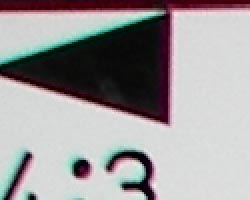 |
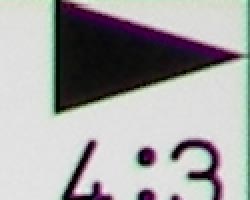 |
| Wide Angle: Bright, top left @ 200% |
Telephoto: Not quite as strong, top right @200% |
Chromatic aberration is high at both ends of the zoom range, showing about 6-8 very bright pixels of coloration at wide angle, somewhat less at telephoto. There's even a very noticeable amount lining the outside edges of the frame. (This distortion is visible as a slight colored fringe around the objects at the edges of the field of view on the resolution target.) Chromatic aberration seems to be the weakest point of the P850's lens. It is excellent in most respects, but its chromatic aberration is at a level more like what we've come to expect from long-ratio zooms.
Corner Sharpness
Minor softening at both wide angle and telephoto.
The Kodak P850 produced only minor blurring in the corners of the frame, at both wide angle and telephoto lens settings. The amount of softening remained consistent in all four corners in both shots, and wasn't particularly noticeable in the other test shots. Again, a very good performance for such a long-ratio zoom lens.
Sensor
Exposure and White Balance
Indoors, incandescent lighting
Moderate color casts with each white balance setting, better than average exposure accuracy.
| Auto White Balance +0.7 EV | Incandescent WB +0.7 EV |
| Manual White Balance +0.7 EV |
Color balance indoors under incandescent lighting was rather reddish with both the Auto and Manual white balance modes, while the Incandescent setting resulted in a fairly strong yellow cast. Auto mode results would probably be acceptable for most consumers, but we'd normally expect the manual white balance option to produce a more neutral cast. The Kodak P850 required only a +0.7 EV exposure compensation boost to get a good exposure, a bit less than most cameras require on this shot. In addition to the reddish cast, overall color is fairly dark, making the blue flowers very dark and purplish. (A very common outcome for this shot.) Our test lighting for this shot is a mixture of 60 and 100 watt household incandescent bulb, a very yellow light source, but a very common one in typical home settings here in the US.
Outdoors, daylight
Colors are a little dark overall, but still pretty good considering the harsh lighting in these shots. Fairly good exposure accuracy, but high contrast.
| Auto White Balance, +1.0 EV | Auto White Balance, Auto Exposure |
Outdoor shots under harsh lighting typically resulted in high contrast with blown out highlights, though the camera actually required about average positive exposure compensation. Shadow detail was also limited, with strong noise that blurred detail in the deepest shadows. That said, the P850 did pretty well with less challenging shots, producing color that was vibrant without seeming overdone.
See full set of test images with explanations
See thumbnails of all test and gallery images
Resolution
Fairly high resolution, 1,150 lines of strong detail.
Our laboratory resolution chart revealed sharp, distinct line patterns down to about 1,150 lines per picture height, with extinction at around 1,600. (The camera did produce slight color artifacts at lower line frequencies though, visible in the full-sized res target shots.) Use these numbers to compare with other cameras of similar resolution, or use them to see just what higher resolution can mean in terms of potential detail. Beware that while you might be able to make out what looks like distinct lines at numbers higher than those we've mentioned here, the camera is just doing its best to continue interpreting the lines. If you zoom in and follow them from the wider portions, you'll see the lines converge and reappear several times, so the lines you see at 1,400 and higher are really only artifacts generated by the camera's imaging system.
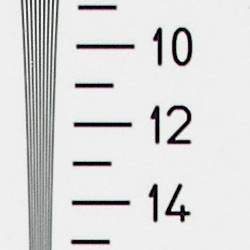 |
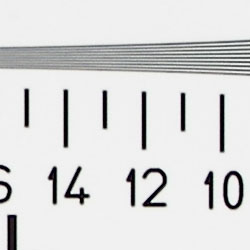 |
| Strong detail to 1,150 lines horizontal | Strong detail to 1,150 lines vertical |
See full set of test images with explanations
See thumbnails of all test and gallery images
Sharpness & Detail
Slightly soft images, with visible noise suppression in lower contrast areas, and edge enhancement in high contrast areas.
The Kodak P850's images are slightly soft overall. Detail appears well defined in the high contrast outdoor crop above, but closer inspection reveals visible artifacts from the camera's edge enhancement. (Edge enhancement creates the illusion of sharpness by enhancing colors and tones right at the edge of a rapid transition in color or tone.)
Noise-suppression systems in digital cameras tend to flatten-out detail in areas of subtle contrast. The effects can often be seen in shots of human hair, where the individual strands are lost and an almost "watercolor" look appears. The crop at far right shows this quite plainly, with limited detail visible, though the brighter strands against darker backgrounds are easily distinguishable.
ISO & Noise Performance
Fairly low noise at the lowest sensitivity setting, though high noise and blurred detail at the higher settings.
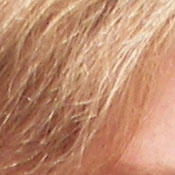 |
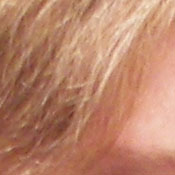 |
| ISO 50 | ISO 100 |
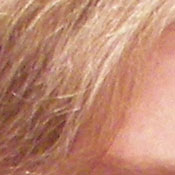 |
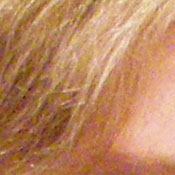 |
| ISO 200 | ISO 400 |
The Kodak P850's 50 ISO setting resulted in pretty low noise, though the noise level was still a bit higher than I'd ideally like at such a low ISO value. As the ISO setting increases, so does the noise level and the amount of blurring that results, and its images at ISO 400 are quite soft with very bright noise pixels. (Note - the blurring in the ISO 100 shot above is most likely due to a slight head movement by Marti, combined with the relatively slow shutter speed.)
Extremes: Sunlit and low light tests
Good resolution and overall detail, though high contrast with limited detail in the highlights and shadows. Pretty good low-light performance, capable of capturing bright images under average city street lighting and slightly darker conditions, but significant difficulty focusing under those conditions.
| +0.7 EV | +1.0 EV | +1.3 EV |
Sunlight:
Because digital cameras are more like slide film than negative film (in that they tend to have a more limited tonal range), we test them in the harshest situations to see how they handle scenes with bright highlights and dark shadows, as well as what kind of sensitivity they have in low light. The shot above is designed to mimic the very harsh, contrasty effect of direct noonday sunlight, a very tough challenge for most digital cameras. (You can read details of this test here.)
The Kodak P850 responded to our deliberately harsh lighting with rather high image contrast, resulting in limited shadow and highlight detail. In the shadows, not only is detail rather limited, but there's a lot of coarse-grained image noise that contributes to the loss of image information. (In "real life" though, be sure to use fill flash in situations like the one shown above; it's better to shoot in the shade when possible.)
Low light:
The P850 acquitted itself pretty well in the low light tests, but did have quite a bit of trouble focusing in dim lighting. Despite a maximum shutter time of 16 seconds, the 50 and 100 ISO settings were still just a bit dim at the very lowest light levels, but the point at which it ran into trouble was less than 1/4 as bright as typical city street lighting at night. At ISOs 200 and up though, it captured bright, usable images at the lowest light level we test at. Color balance was pretty accurate with the Auto white balance setting.
The big limitation of the P850 for low light shooting is its autofocus system. It had quite a bit of trouble focusing in even moderately dim lighting, and has no AF assist lamp to aid it in dark conditions. The end result is that we had to manually focus the camera throughout most of this test. Keep in mind that the longer shutter speeds used here necessitate the use of a tripod or some camera stabilizer to prevent blurring from camera movement. (A useful trick is to just prop the camera on a convenient surface, and use its self-timer to release the shutter. This avoids any jiggling from your finger pressing the shutter button, and can work quite well when you don't have a tripod handy.)
NOTE: This low light test is conducted with a stationary subject, and the camera mounted on a sturdy tripod. Most digital cameras will fail miserably when faced with a moving subject in dim lighting. (For example, a child's ballet recital or a holiday pageant in a gymnasium.) For such applications, you may have better luck with a digital SLR camera, but even there, you'll likely need to set the focus manually. For information and reviews on digital SLRs, refer to our SLR review index page.
Color
Saturation & Hue Accuracy
Somewhat oversaturated color (especially strong reds and blues), though generally good hue accuracy, despite moderate color casts.
The other important part of color rendition is hue accuracy. Hue is "what color" the color is. Here, the Kodak P850 performed very well, though the overall color balance had a pretty strong effect on how true colors appeared in our test shots. For example, the Manual and Auto white balance settings often resulted in a more reddish color, which thus altered the overall hue accuracy for a shot. With a light source that it could get a good color balance to, the P850 delivered quite accurate color. As with most digital cameras these days, cyan hues are shifted toward pure blue to produce better-looking sky colors, but color in other parts of the spectrum was unusually accurate.
Viewfinder
Coverage
Very good accuracy with both the LCD monitor and electronic optical viewfinder (EVF).
| 36mm eq., EVF | 432mm eq., EVF |
| 36mm eq., LCD monitor | 432mm eq., LCD monitor |
Both the P850's electronic optical viewfinder (EVF) and LCD monitor showed very good frame accuracy, at about 100% at wide angle, and about 98% for telephoto.
Flash
Coverage and Range
A powerful flash, with less than average positive compensation required, but very uneven coverage at wide angle.
| 36mm equivalent | 432mm equivalent |
| Normal Flash +0.7 EV | Slow-Sync Flash Default Exposure |
Flash coverage was very uneven at wide angle but much more uniform and brighter at telephoto. On the Indoor test, the flash on the P850 underexposed our subject at its default setting just a little, requiring a +0.7 EV exposure compensation adjustment to get bright results. (Most cameras we test need about +1.0 EV for this shot.) The camera's Slow-Sync flash mode produced slightly brighter and more even results, albeit with a stronger orange cast from the room lighting. The Slow-Sync shot required no positive exposure compensation, due to the longer exposure time.
| 8 ft | 9 ft | 10 ft | 11 ft | 12 ft | 13 ft | 14 ft |
1/80 sec f3.2 ISO 100 |
1/80 sec f3.2 ISO 100 |
1/80 sec f3.2 ISO 100 |
1/80 sec f3.2 ISO 100 |
1/100 sec f3.6 ISO 100 |
1/100 sec f3.6 ISO 100 |
1/100 sec f3.6 ISO 100 |
The P850's flash provided bright, consistent illumination all the way to 14 feet.
Output Quality
Print Quality
Good print quality, great color, good 11x14 inch prints. ISO 200 images are soft at 8x10, usable at 5x7, ISO 400 shots are very rough at 8x10, usable at 4x6.
Testing hundreds of digital cameras, we've found that you can only tell just so much about a camera's image quality by viewing its images on-screen. Ultimately, there's no substitute for printing a lot of images and examining them closely. For this reason, we now routinely print sample images from the cameras we test on our Canon i9900 studio printer, and on the Canon iP5000 here in the office. (See the Canon i9900 review for details on that model.)
With the Kodak EasyShare P850, we found that it had enough resolution to make good-looking 11x14 prints, and very sharp 8x10s. At high ISO, image noise levels were rather high. ISO 200 shots were soft when output as 8x10 prints, although they were possibly still usable for wall display, but looked OK at 5x7 inches. ISO 400 shots were quite rough though, acceptable only when printed at a 4x6 inch size, and still a bit rough-looking even there. The Kodak P850's color was just great though, very bright and vibrant looking, without appearing at all unnatural, and managing to maintain a proper saturation level on skin tones.
Timing and Performance
Kodak P850 Timing
Mixed results, with fast timing in some areas, but slower performance in others.
| Startup/Shutdown: | |
| Power On to first shot | 3.8 seconds |
| Shutter response (Lag Time): | |
Full Autofocus Wide |
0.70 second |
Full Autofocus Tele |
0.55 second |
Prefocused |
0.095 second |
| Cycle time (shot to shot) | |
| Normal large/fine JPEG | 1.84 seconds |
| Flash recycling | 3 seconds |
| Continuous mode | 0.56 second 1.80 frames/second (5 large/fine frames) |
| Download speed | |
| Windows Computer, USB 2.0 | 394 KBytes/sec |
The P850 ranked among both the faster and the slower models currently on the market, depending on what it is you're trying to do. For example, startup time is rather slow, as the camera takes a while to startup the LCD and extend the 12x zoom lens. However, shutter lag is fairly fast, with good times at wide angle and telephoto, and excellent results with prefocus (accomplished by halfway pressing the Shutter button to set focus). Cycle times are about average for large/fine files, though Continuous mode proved reasonably fast. It was rather slow clearing its buffer though, even when using a very fast memory card. (Kingston 133x SD card.) The camera had an annoying habit of performing a full autofocus cycle every time we touched the zoom lever though, in many cases delaying the framing of our shots. Connected to a computer, download speeds are really quite slow, although the convenience of the Kodak EasyShare Camera Dock and the auto-download feature of the EasyShare Software somewhat make up for this.
Battery and Storage Capacity
Battery
Pretty good battery life with the LCD on, slightly better when using the EVF. Still, not a bad idea to get a spare battery.
| Still-image capture mode LCD on |
145 minutes |
| Still-image capture mode LCD off |
153 minutes |
| Image playback LCD on |
274 minutes |
The Kodak EasyShare P850 uses a custom rechargeable LiIon battery for power, and delivers fairly good run times for a camera in its class. The table above shows maximum run times based on our power measurements and the rated performance of its battery. While a run time of almost two and a half hours isn't bad, we still highly recommend purchasing a second battery to pack along on extended outings.
Storage
No memory card is included with the Kodak EasyShare P850, although it accepts SD/MMC cards; 32MB RAM is built into the camera.
32MB Internal Memory |
Fine | |
| 2,592 x 1,944 | Images | 9 |
| File Size | 3.6 MB | |
| 2,048 x 1,536 | Images | 15 |
| File Size | 2.2 MB | |
| 1,664 x 1,248 | Images | 22 |
| File Size | 1.4 MB | |
| Images | 37 | |
| File Size | 883 K | |
We strongly recommend buying at least a 128MB, or preferably a 256MB SD memory card, to give yourself extra space for extended outings.
| Pro: | Con: |
|---|---|
|
|
Kodak's EasyShare line of digital cameras has long been a favorite among a wide range of consumers, as the cameras pretty universally live up to the "Easy" in their name. While somewhat more advanced than the typical EasyShare model, the new P850 offers a wide range of exposure and creative control without compromising usability. The P850 offers partial and full manual exposure modes for the more advanced consumers, but also maintains a healthy selection of automatic and preset shooting modes for novices. Plus, the P850 continues with Kodak's popular EasyShare features, including printer and camera dock compatibility, the Share menu for tagging images for printing, downloading, and emailing, as well as the Favorites mode for viewing a digital photo album. The camera's 5.0-megapixel (effective) CCD captures high resolution images, and its image-stabilized 12x optical zoom is a nice bonus as well. We did find its tendency to blur the viewfinder display for as long as a couple of seconds after even minor zoom adjustments rather annoying though, and its autofocus system had more difficulty with dim lighting than we like to see. The P850 does indeed combine ease of use with a long zoom and advanced features, but we found its focusing foibles too much to get past. Overall, an excellent choice for stable long-telephoto shots in daylight, but not a good solution if you frequently need to shoot under dimmer interior lighting.
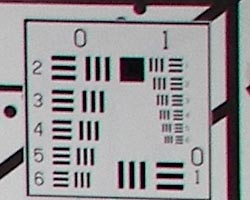
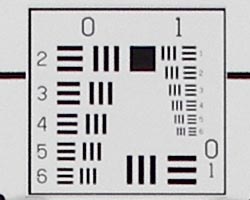
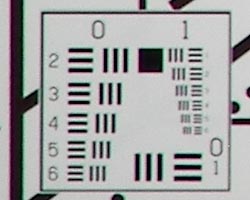
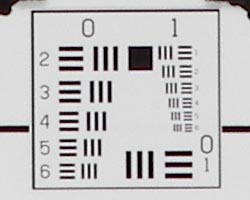
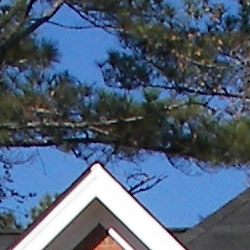
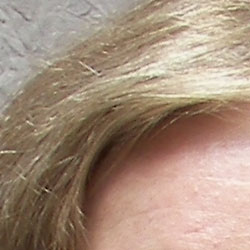
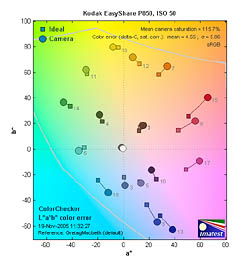

Follow Imaging Resource: